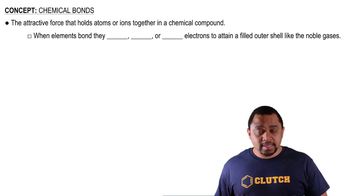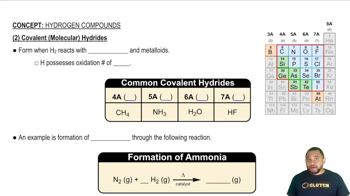Here are the essential concepts you must grasp in order to answer the question correctly.
Chemical Bonding
Chemical bonding refers to the forces that hold atoms together in a compound. There are two primary types of bonds: ionic and covalent. Ionic bonds form when electrons are transferred from one atom to another, typically between metals and nonmetals, resulting in charged ions. Covalent bonds, on the other hand, involve the sharing of electrons between atoms, usually between nonmetals.
Recommended video:
Ionic Compounds
Ionic compounds are formed when metals react with nonmetals, resulting in the transfer of electrons and the formation of ions. These compounds typically have high melting and boiling points and are soluble in water. In the context of the question, potassium (K) would form an ionic compound with hydrogen and sulfur, as it is a metal that readily loses an electron to form a positive ion.
Recommended video:
Covalent Compounds
Covalent compounds are formed when two nonmetals share electrons to achieve a full outer shell. These compounds usually have lower melting and boiling points compared to ionic compounds and may not conduct electricity in solution. In the case of hydrogen and sulfur, they would form a covalent compound (H2S) as both are nonmetals that share electrons rather than transferring them.
Recommended video:
Covalent (Molecular) Hydrides
 Verified step by step guidance
Verified step by step guidance

